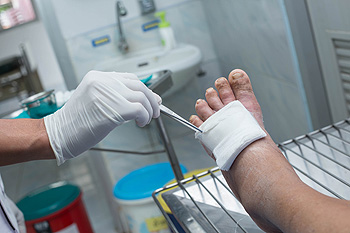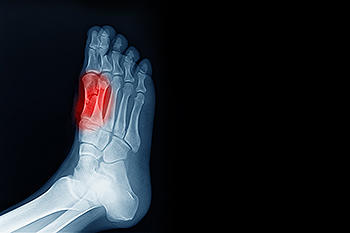
Cedarhurst (516) 374-3668
Franklin Square (516) 775-8440

Cedarhurst (516) 374-3668
Franklin Square (516) 775-8440

Recovering from hammertoe surgery requires attentive care to ensure proper healing and prevent complications. Follow your doctor's instructions regarding pain relief and any prescribed antibiotics to avoid infection. Keeping the pain under control will also help you stay mobile and adhere to post-surgery exercises. A balanced diet rich in vitamins and minerals supports the healing process, with particular emphasis on nutrients like vitamin C and protein to aid tissue repair. Incision care is vital for preventing infections includes keeping the surgical site clean and dry and following your podiatrist's guidelines on changing dressings. Avoid soaking the foot until the incision is fully healed, and watch for signs of infection like increased redness, swelling, or discharge. Elevating the foot and limiting activity as recommended will reduce swelling and promote faster recovery. If you have had hammertoe surgery, it is suggested that you keep in close contact with your podiatrist who can monitor your recovery.
Foot surgery is sometimes necessary to treat a foot ailment. To learn more, contact Robert Stein, DPM of South Shore Foot Care. Our doctor will assist you with all of your foot and ankle needs.
When Is Surgery Necessary?
Foot and ankle surgery is generally reserved for cases in which less invasive, conservative procedures have failed to alleviate the problem. Some of the cases in which surgery may be necessary include:
What Types of Surgery Are There?
The type of surgery you receive will depend on the nature of the problem you have. Some of the possible surgeries include:
Benefits of Surgery
Although surgery is usually a last resort, it can provide more complete pain relief compared to non-surgical methods and may allow you to finally resume full activity.
Surgical techniques have also become increasingly sophisticated. Techniques like endoscopic surgery allow for smaller incisions and faster recovery times.
If you have any questions please feel free to contact our offices located in Cedarhurst and Franklin Square, NY . We offer the newest diagnostic and treatment technologies for all your foot and ankle needs.

Diabetic foot ulcers pose a significant risk to individuals with diabetes, often occurring on the ball of the foot or the bottom of the big toe. While some foot ulcers may not cause pain, it's important to seek immediate medical attention, as neglecting them can lead to infections and potential limb loss. Treatment approaches vary depending on the severity of the diabetic foot ulcer. Among them are X-rays to assess bone health and debridement, or cleaning out dead tissue, which may require hospitalization. Special footwear or braces may be recommended to protect the foot and aid healing. In cases of poor circulation, consultation with a vascular surgeon may be necessary. Even after an ulcer heals, ongoing care is vital to prevent recurrence, including the use of specialized footwear and daily foot monitoring for any sores or trouble spots. Individuals with diabetes face a higher risk of amputation, due to complications like peripheral artery disease and neuropathy, but limb loss can be prevented with regular foot care, proper medical supervision, and suitable footwear. Dealing with diabetic foot ulcers includes having a podiatrist as a member of your healthcare team. For help with foot ulcers, it is suggested that you make an immediate appointment with a podiatrist for care.
Diabetic foot care is important in preventing foot ailments such as ulcers. If you are suffering from diabetes or have any other concerns about your feet, contact Robert Stein, DPM from South Shore Foot Care. Our doctor can provide the care you need to keep you pain-free and on your feet.
Diabetic Foot Care
Diabetes affects millions of people every year. The condition can damage blood vessels in many parts of the body, especially the feet. Because of this, taking care of your feet is essential if you have diabetes, and having a podiatrist help monitor your foot health is highly recommended.
The Importance of Caring for Your Feet
Patients with diabetes should have their doctor monitor their blood levels, as blood sugar levels play such a huge role in diabetic care. Monitoring these levels on a regular basis is highly advised.
It is always best to inform your healthcare professional of any concerns you may have regarding your feet, especially for diabetic patients. Early treatment and routine foot examinations are keys to maintaining proper health, especially because severe complications can arise if proper treatment is not applied.
If you have any questions please feel free to contact our offices located in Cedarhurst and Franklin Square, NY . We offer the newest diagnostic and treatment technologies for all your foot and ankle needs.

The human foot is a marvel of engineering, comprising a complex interplay of bones, muscles, ligaments, and blood vessels that work seamlessly to support our weight, absorb shock, and propel us forward. At the heart of this structure lies the arch, which acts as a natural shock absorber, distributing forces evenly as we walk, run, or stand. Supporting the arch are muscles and ligaments that form a dynamic system, constantly adjusting to maintain balance and stability. Meanwhile, the toes play a vital role in balance and propelling us forward, while gripping the ground with each step and helping us navigate uneven terrain. Beneath the surface, a network of blood vessels ensures adequate oxygen and nutrients reach the tissues, supporting their function and repair. Foot pain can happen for a variety of reasons, and it may be connected to a mishap or a foot deformity. If you have foot pain for any reason, it is suggested that you visit a podiatrist who is an expert in treating such conditions.
If you have any concerns about your feet, contact Robert Stein, DPM from South Shore Foot Care. Our doctor can provide the care you need to keep you pain-free and on your feet.
Biomechanics in Podiatry
Podiatric biomechanics is a particular sector of specialty podiatry with licensed practitioners who are trained to diagnose and treat conditions affecting the foot, ankle and lower leg. Biomechanics deals with the forces that act against the body, causing an interference with the biological structures. It focuses on the movement of the ankle, the foot and the forces that interact with them.
A History of Biomechanics
Modern technological improvements are based on past theories and therapeutic processes that provide a better understanding of podiatric concepts for biomechanics. Computers can provide accurate information about the forces and patterns of the feet and lower legs.
Understanding biomechanics of the feet can help improve and eliminate pain, stopping further stress to the foot.
If you have any questions please feel free to contact our offices located in Cedarhurst and Franklin Square, NY . We offer the newest diagnostic and treatment technologies for all your foot and ankle needs.

Sesamoiditis, a condition caused by inflammation of the sesamoid bones located beneath the big toe joint, can pose significant discomfort and mobility challenges. These small, pea-sized bones play a vital role in weight-bearing and stabilizing the foot during activities like walking and running. When subjected to excessive pressure or repetitive stress, the sesamoid bones may become inflamed, leading to symptoms such as sharp or dull pain beneath the big toe joint, and swelling. Sesamoiditis typically manifests as a gradual onset of pain, worsening with activity and improving with rest. Activities that involve pushing off the toes, such as jumping or running, may worsen symptoms. Diagnosis of sesamoiditis involves a comprehensive evaluation by a podiatrist, including a physical examination and possibly imaging tests such as X-rays or MRI scans. If you have pain under the big toe, it is suggested that you contact a podiatrist who can provide you with effective treatment solutions.
Sesamoiditis is an unpleasant foot condition characterized by pain in the balls of the feet. If you think you’re struggling with sesamoiditis, contact Robert Stein, DPM of South Shore Foot Care. Our doctor will treat your condition thoroughly and effectively.
Sesamoiditis
Sesamoiditis is a condition of the foot that affects the ball of the foot. It is more common in younger people than it is in older people. It can also occur with people who have begun a new exercise program, since their bodies are adjusting to the new physical regimen. Pain may also be caused by the inflammation of tendons surrounding the bones. It is important to seek treatment in its early stages because if you ignore the pain, this condition can lead to more serious problems such as severe irritation and bone fractures.
Causes of Sesamoiditis
Treatment for sesamoiditis is non-invasive and simple. Doctors may recommend a strict rest period where the patient forgoes most physical activity. This will help give the patient time to heal their feet through limited activity. For serious cases, it is best to speak with your doctor to determine a treatment option that will help your specific needs.
If you have any questions please feel free to contact our offices located in Cedarhurst and Franklin Square, NY . We offer the newest diagnostic and treatment technologies for all your foot and ankle needs.
Every patient is unique and so are treatments. The information on this website is for educational purposes and each individual
patient care model may differ.